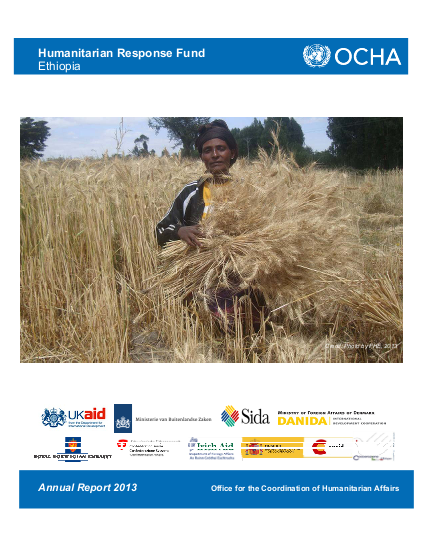
The HRF funding strategy during the first half of 2013 was to prioritize livelihood interventions, by linking beneficiary targeting between livelihood and ongoing emergency nutrition activities in order to enhance the sustainability of the humanitarian response. This strategy was revised during the mid-year review of the HRF as a low funding balance required prioritization of urgent humanitarian needs. Fifty-three projects valued at US$ 27.9 million and covering a wide range of emergency response activities were funded, including postarrival assistance to thousands of Ethiopians from Saudi Arabia and Yemen, support to malnourished children and the displaced, national and regional vaccination campaigns, emergency WASH projects and ensuring humanitarian air services. The Fund ended the year with a balance of only US$ 5.7 million, the lowest level in several years. Contributions of US$ 2.2 million received in December from the Governments of Sweden and Switzerland increased the end of year balance. During the year, the HRF was the first point of response for unforeseen emergencies, particularly during the unprecedented large scale return of Ethiopian migrants deported from Saudi Arabia in November. The HRF was the first to quickly redirect the first tranche of funds from unexpended costs of a previous allocation provided to support similar protection services to Ethiopian migrants stranded in Yemen. A total of US$ 2.5 million was allocated to the International Organization for Migration (IOM) to provide post-arrival assistance including food, non-food items (NFIs), health services and temporary shelter in Addis Ababa, as well as to cover the costs of onward transportation and small reintegration cash grants. As part of a broader strategy by OCHA and humanitarian/development partners to reestablish presence in the area, the HRF funded a nutrition-sensitive livestock intervention in Fik (Nogob) zone in Somali Region. Access to the zone was restricted for international partners for the last two years following a security incident that involved a WFP staff. The project aimed to promote recovery of livestock conditions and thereby improved the nutrition status of the widely pastoralist communities. The HRF supported its first stand-alone Education in Emergencies (EiE) project in conflict-affected areas of Meyu and Kumbi woredas of East Hararge zone, Oromia Region. The activities provided access to basic education to 7,676 school-age children out of which 37 per cent were girls. In collaboration with the Department for International Development (DFID), the HRF Section developed the Business Case and LogFrame. The adoption of the Log-frame will strengthen OCHA’s partnership with donors and also potentially inform a standardized accountability framework for all Country-Based Pooled Funds (CBPF). Staff support to other CBPF programmes, Emergency Response Funds (ERF) and Common Humanitarian Funds (CHF), was provided by the HRF during the year. The HRF Manager supported the CHF Somalia management for six months, while the Monitoring officer provided extended support to the ERF in Syria. Such missions are encouraged as it promotes experience sharing between different CBPFs. As part of the UN Board of Auditor’s (BoA) global exercise, the HRF hosted a mission by the BoA to conduct a performance audit on OCHA’s strategic engagement with implementing partners. In 2013, Ethiopia was one of the case studies of the BoA to inform its report to the General Assembly. The main purpose of the visit was to examine the Fund’s programmatic mandate and management system. Some members of the team also visited projects in Southern Nations, Nationalities, and People’s Region (SNNPR). Other major activities delivered with HRF funding include: ? 17,225 children with Severe Acute Malnutrition (SAM) in Outpatient Therapeutic Programmes (OTPs) and an additional 877 children suffering from SAM with medical complications in Stabilization Centers (SCs) were treated. A further 53,456 children, 7,242 elders and 60,987 pregnant and nursing mothers with Moderate Acute Malnutrition (MAM) also received treatment; ? 115,022 households were provided with seed and tubers and some 20,850 households were targeted for livestock interventions; ? 11,530 migrants deported from Saudi Arabia and 780 migrants from Yemen were provided with post arrival lifesaving assistance. All applications were appraised for conformity with ERF guidelines and alignment with HRF priorities – emergency response, coordination considerations and cost effectiveness. Applications meeting the basic requirements were circulated to the respective clusters for review by Cluster leads and key sector partners to ensure technical quality, sound methodology and adherence to national/sectoral guidelines and regional priorities. Revised applications were then forwarded to the Review Board for funding recommendations. The HRF Review Board made funding recommendations for each project based on the proposal’s merit, conforming to agreed priorities and strategies and in addressing identified emergency needs. OCHA submitted the Board’s recommendation to the Humanitarian Coordinator (HC) for approval.
